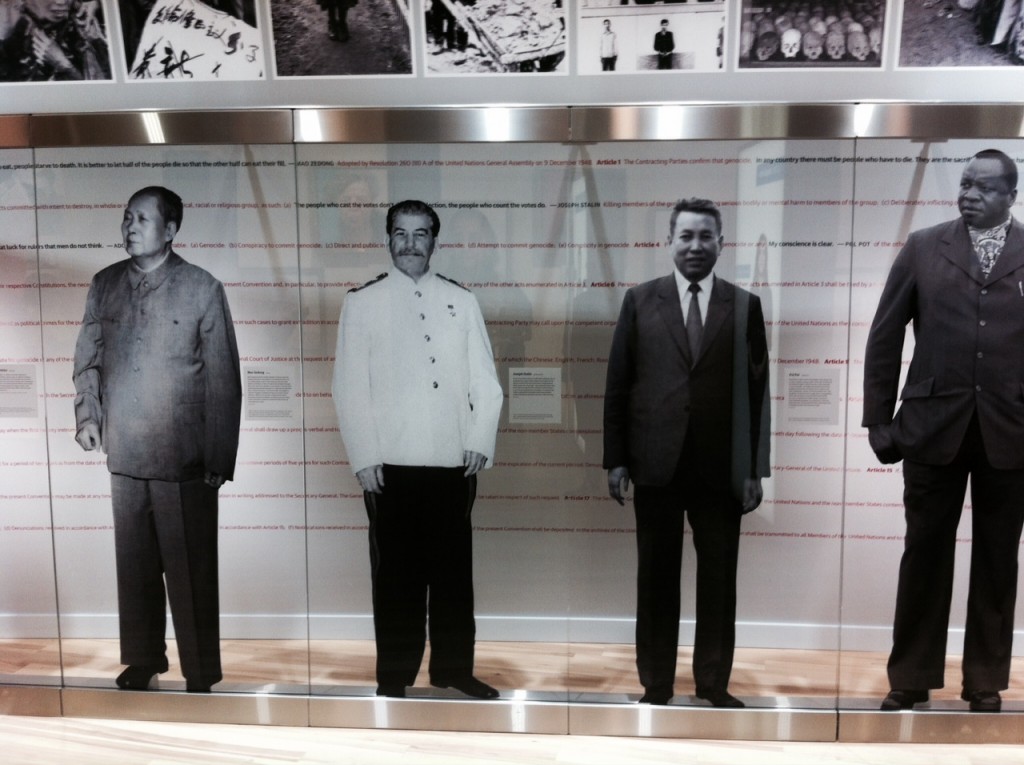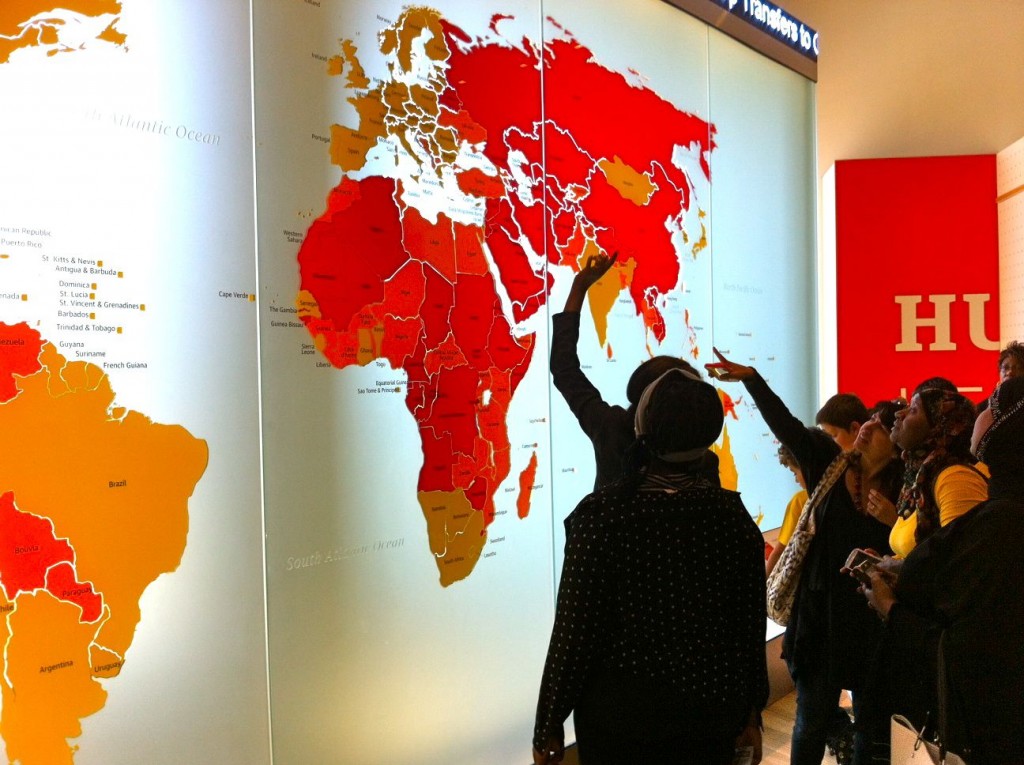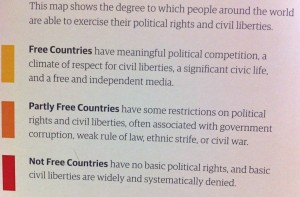It feels unfair to have two posts that both veer toward the critical of the work of the Center for Civil and Human Rights in Atlanta, but here I am writing another on the heels of the Advertorial Museum. I hope these thoughts are of use to others who may face analogous curatorial challenges, and even as I seek to detonate a kind of land mine, I would like to applaud the Center for Civil and Human Rights for venturing into this territory at all. The entire second floor is dedicated to The Universal Declaration of Human Rights, an important document deserving of attention. So I am thrilled at the attempt to shed light in an area that suffers from mental neglect, but even as I am loath to make this critique, I feel compelled to do so.
I hope it is taken in the spirit it is meant—as an invitation to thought. The whole Center for Civil and Human Rights certainly was that for me, even if not perhaps in the way its conceivers and creators envisioned.
States of society
On the second floor of the Center for Civil and Human Rights in Atlanta is a huge World Map of Freedom. It’s the last thing you take in if you follow what I imagine to be the most common flow pattern for the museum. It commands attention and gets it.
As I was looking at it, I found myself listening to the conversations it inspired among both children and adults. Its categorization of the world into Free Countries, Partly Free Countries, and Not Free Countries was immediately grasped and seemingly accepted without challenge by all I observed. The authority of “the museum” was seemingly being consulted like an oracle. What state of freedom is my country? How do we fare? Adults and children alike seemed to be driven to find their home countries to receive a verdict. All seemed to take it on faith and acknowledge their fate with emotions such as relief or disappointment. As I witnessed this absorption of a message given authority by its being represented so large and so convincingly in the context of a trusted sanctuary of knowledge—a museum—I could not help but recall Todd Ayong‘s artwork Perverse Double, in which he uses Warren’s Common School Geography Textbook from 1877 as the fertile ground for a critique of colonialism and our own post-colonial present.
This textbook was used widely in the United States throughout the latter half of the 19th century. Like the panel on the World Map of Freedom, this page in the then-authoritative textbook succinctly classifies ALL the peoples and governments of the world.
Warren’s schema has four “states” instead of three (which are derived from the work of Freedom House), but it is otherwise eerily similar in its effect. The children I watched interact absorbed the message from this map and got it immediately. But what did they get?
The authority of “the museum” was seemingly being consulted like an oracle.
I quote below this textbook at length (E.H. Butler and Co., Philadelphia 1877) because I think it’s worth seeing how strange these assertions seem now from our 21st Century vantage and sensibilities. It also gives us an insight into the bias—conscious and unconscious—that is built into nearly all interpretation.
STATES of Society are the conditions of people as regards political divisions, occupations, government, religion, education, etc. The various nations and tribes of men are classed as savage, barbarous, half-civilized, and civilized.
1. Savages are the lowest and most degraded class. They have no political divisions or towns, few and rude occupations, cruel or weak government, degrading religion, and no education … The American Indians, many of the negro tribes of Africa, and all of the native tribes of Australia are savages.
2. In the Barbarous State men are somewhat more advanced than in the savage. They have indefinite political divisions, patriarchal or tribal government, nomadic occupations, Pagan or Mohammedan religion, and meager education … The wandering tribes who inhabit the great plateaus of Central Asia, the Bedouins of Arabia, and the Tuaricks and some of the Moorish tribes of Northern Africa belong to this class.
Savage and barbarous nations have very imperfect ideas of good and evil and very little aptitude for labor. They are almost always engaged in war. They are addicted to plunder and robbery, are cruel and revengeful, and generally treat their women as inferior beings.
3. Half-civilized nations have definite political divisions and large towns … They have Mohammedan, Buddhist, or Brahman religions and narrow education. They are jealous of strangers, and have very little communication with foreign countries … Most of the half-civilized nations inhabit the Eastern Continent. The Persians, Turks, Hindoos, and Chinese are half-civilized.
4. Civilized Nations have many political divisions for the purpose of local self-government, and many cities and villages. They practice all the manual and professional occupations, have constitutional governments, Christian or Jewish religion, and many public schools and schools of higher education.
Some nations belong to more than one of these classes. Most of the civilized nations belong to the Caucasian race. Nearly all the inhabitants of Europe, and their descendants in America and other parts of the world, belong to this class. Civilization has made comparatively little progress among the four colored races. The Chinese and Japanese are the only nations of the Mongolian race that possess any civilization. The Ethiopian race has never produced a civilized nation. The inhabitants of Java are the only representatives of the Malay race who have reached a position above the barbarous state, and the Spanish conquerors in Mexico and Peru destroyed the only efforts at civilization by the American Indians.
In light of the above definitional rubric, one is perhaps led to a difficult but important question: Do the definitions given on the Center for Civil and Human Rights’ World Map of Freedom have roots in a worldview that suffers from latent prejudice, a sort of “culturism”?
Do the definitions given on the Center for Civil and Human Rights’ World Map of Freedom have roots in a worldview that suffers from latent prejudice, a sort of “culturism”?
It seems clear from the definitions given on the world map that Free = Good. In passing judgment on the degree of “freedom” in these countries, one cannot escape the feeling that we are also assigning value judgments—”here in America, we are good, free, and have things under control,” while other countries are “backward,” “corrupt,” “unfree,” and ultimately, ignorant of The Good.
It’s a classic case of consider the source. These definitions come from a self-labeling “free” country, giving itself the definitional power to assert of others that they are either free and inclusive of practices of respect and meaning, or “partially” or “not free” and therefore, sites of corruption devoid of real civil and political rights.
You and I may bring a more skeptical eye to such pronouncements, taking into consideration such things as cultural context, motivations, linguistic-emotional mechanisms, and effects. But what of the children (and adults) who more or less take these definitions at face value? (I witnessed only this.) Are these and similar definitions perpetuating a kind of constructed hegemony in which the West and its allies have a monopoly on freedom? Do we, in fact?
Once convinced that we live in a “free” country where political and civil rights are genuinely protected, what then? Do we pat ourselves on the back, content that our work here is done?
Recognizing problems is an impetus for positive social change, and the reality of our situation, as evidenced by the ongoing unrest in Baltimore and elsewhere, is that we do still have problems. Though “separate but equal” is no longer publicly sanctioned, racism, prejudice, and social injustice still run rampant throughout the United States as elsewhere. Refuse to acknowledge the problems then what’s next? Do we cease striving for positive social change and instead simply declare “mission accomplished”?

As with the questions raised by the Advertorial Museum post that precedes this one, the definitions given on The World Map of Freedom raise a more generally applicable question: Are we too focused on selling something to the museum consumer—whether it be a bottle of Coke or a feeling of self-satisfaction—to tell a more truthful and perhaps more complicated and thought-provoking story?
—
Photos by the author




Ask for help.
We are kind, thorough and ready when you are. You just need to ask.